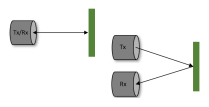Sonar makes use of acoustic signals (usually ultrasound), measuring distance using sound waves.
- A speaker/transmitter emits/receives an acoustic wave (~40 kHz)
- The time of return can be translated into distance using the speed of sound ()
Configurations:
- Bistatic: Separate transducer for transmit/receive
- Monostatic: One unit for both transmit and receive

Sonar performance depends heavily on environment, such as object shape, surface material, and environmental variables.
Pros:
- Good for short distances
- Good for indoor
- Very low cost
- Suffers from noise (false echoes, missed readings, etc.)
To use sonar for mapping, the sonar data needs to be swept (rotated) to map the environment, which requires a rotating servo. Alternatively, one can also use an array of sonar.